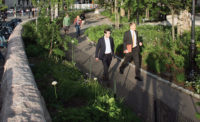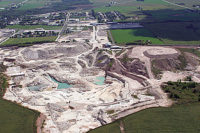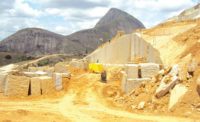A total of 110 workers are at the quarry, and they produce 900 cubic meters of stone annually. The quarry is primarily marble, with schist in the middle. The marble varies in four shades — white, cream, champagne and salmon — and contains more pink hues the closer it is to the mica schist because of its iron oxide. The marble in this part of the quarry also is stronger and can be cut into larger blocks.
According to Solubema, the marble in the region is approximately 450 million years old, and it is predicted that the quarry has another 1,000 years of production. While the material is supplied to the U.S. for specific projects, the Middle East and Europe are Solubema’s primary markets. Slabs are mostly sold to the Middle East, blocks to Italy and the market in India is a combination of slabs and blocks.
To extract the marble, the material is first drilled with a hammer and then cut with a chainsaw. The next step is to make a vertical cut with diamond wire. A bench is then pulled down with an excavator.
Blocks are a maximum of 32 tons. The good material is sent to customers and what is left is sent to a “dumping” area or crushed for civil engineering projects. All of the blocks that are extracted are numbered with the name of the quarry, which allows Solubema’s workers at the factory to know where the block came from in the quarry.
The factory
Solubema maintains a stocked slab yard that is arranged by material and color. The cream-colored variety of marble is the most popular, according to the company.
At the stone processing facility, three Breton gangsaws and five smaller gangsaws from a Portuguese manufacturer are in place to cut the blocks. The smaller gangsaws are used to cut limestone blocks that the company purchases.
The company’s facility includes a 3,000-square-meter slab plant, which is equipped with a Levibreton KFG slab polishing line. After the slabs go through the polishing line any ones with small cracks are laid out and manually glued. They are then re-polished.
There is a second polishing line in another building at Solubema’s stone processing facility. Additional equipment used in the production process includes a Pedrini tile saw and two Breton Speedycut CNC bridge saws.












